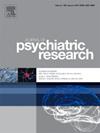Autism characteristics in young patients with first episode of schizophrenia spectrum disorder: findings from a 2-year longitudinal research
IF 3.7
2区 医学
Q1 PSYCHIATRY
引用次数: 0
Abstract
Purpose
The PANSS Autism Severity Score (PAUSS) is a recent popular measure of autistic characteristics in Schizophrenia Spectrum Disorders (SSD). Evidence on its factor structure, longitudinal course, and treatment response is poor. The main aims of this investigation were: to examine its internal consistency and factor configuration in young patients with first-episode SSD treated in an Early Intervention (EI) service, and to compare clinical outcomes between SSD individuals with or without “autistic features” across 2 years of follow-up, as well as their treatment response.
Methods
SSD participants completed the Positive And Negative Syndrome Scale (PANSS), the Global Assessment of Functioning (GAF), and the Health of the Nation Outcome Scale (HoNOS) across the follow-up. Statistical tests included the α statistic, Exploratory Factor Analysis, Kaplan-Meyer survival analysis, mixed-design ANOVA, and multiple linear regression analysis.
Results
170 SSD individuals were enrolled (58 [34.1 %] scoring above the PAUSS cut-off [PAUSS+]). Internal consistency of the PAUSS was acceptable (α = .792). EFA identified a 3-factor model. At baseline, PAUSS + individuals showed greater severity in psychopathology and social decline. Across the follow-up, PAUSS + individuals had lower incidence rates of symptomatic remission. No PAUSS long-term stability was found, but a significant reduction that was predicted by lower antipsychotic dosage and higher number of case management sessions offered along the follow-up.
Conclusions
The PAUSS seems to capture a SSD subgroup characterized by higher baseline severity levels in psychopathology and poorer outcomes.
首次发作精神分裂症谱系障碍的年轻患者的自闭症特征:一项为期2年的纵向研究的结果
目的PANSS自闭症严重程度评分(PAUSS)是最近流行的一种衡量精神分裂症谱系障碍(SSD)自闭症特征的方法。关于其因素结构、纵向病程和治疗反应的证据不足。本研究的主要目的是:检查在早期干预(EI)服务中治疗的首发SSD年轻患者的内部一致性和因素配置,并比较具有或不具有“自闭症特征”的SSD个体在2年随访中的临床结果,以及他们的治疗反应。方法sssd参与者在随访期间完成了阳性和阴性综合征量表(PANSS)、整体功能评估(GAF)和国民健康结局量表(HoNOS)。统计检验包括α统计、探索性因子分析、Kaplan-Meyer生存分析、混合设计方差分析和多元线性回归分析。结果170例SSD患者入组,其中58例(34.1%)得分高于PAUSS分值[PAUSS+]。PAUSS内部一致性可接受(α = .792)。EFA确定了一个三因素模型。在基线时,PAUSS +个体在精神病理和社会衰退方面表现出更严重的程度。在整个随访过程中,PAUSS +个体的症状缓解发生率较低。没有发现PAUSS的长期稳定性,但通过降低抗精神病药物剂量和增加随访期间的病例管理会议数量,可以预测其显著降低。结论PAUSS似乎捕获了一个SSD亚组,其特点是精神病理的基线严重程度较高,预后较差。
本文章由计算机程序翻译,如有差异,请以英文原文为准。
求助全文
约1分钟内获得全文
求助全文
来源期刊

Journal of psychiatric research
医学-精神病学
CiteScore
7.30
自引率
2.10%
发文量
622
审稿时长
130 days
期刊介绍:
Founded in 1961 to report on the latest work in psychiatry and cognate disciplines, the Journal of Psychiatric Research is dedicated to innovative and timely studies of four important areas of research:
(1) clinical studies of all disciplines relating to psychiatric illness, as well as normal human behaviour, including biochemical, physiological, genetic, environmental, social, psychological and epidemiological factors;
(2) basic studies pertaining to psychiatry in such fields as neuropsychopharmacology, neuroendocrinology, electrophysiology, genetics, experimental psychology and epidemiology;
(3) the growing application of clinical laboratory techniques in psychiatry, including imagery and spectroscopy of the brain, molecular biology and computer sciences;
 求助内容:
求助内容: 应助结果提醒方式:
应助结果提醒方式:


